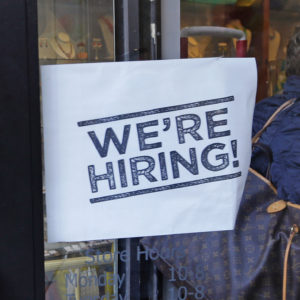The economy is continuing to experience employment growth with the addition of 156,000 new jobs in the month of August, detailed a federal report Friday.
President Donald Trump has overseen steady employment growth since entering office earlier this year. The positive trend started in the final years of the last administration. The Bureau of Labor Statistics found in its latest jobs report that the trend continued with 156,000 new jobs.
“Total nonfarm payroll employment increased by 156,000 in August, and the unemployment rate was little changed at 4.4 percent,” the report states. “Job gains occurred in manufacturing, construction, professional and technical services, health care, and mining.”
Employment growth in recent months have typically been closer to 200,000 new jobs. This past year has seen employment growth that has averaged 176,000 per month. Former President Barack Obama also started seeing steady job growth towards the end of his presidency with his last year averaging 187,000 new jobs.
The labor market was slow to recover in the decade since the last recession. But positive signs in recent years have sparked increased confidence within the embattled economy. The unemployment rate has become one of the more positive labor market indicators. It currently stands close to full employment at 4.4 percent.
“Employment has continued to grow,” Orley Ashenfelter, a professor of economics at Princeton University, told InsideSources. “People are moving back into the labor force. Despite that, the unemployment rate is very low. It’s almost a record now in post-war history.”
Ashenfelter adds that one significant problem that persists is that wages have been slow to grow. Average wages increased by three cents and now sit at $26.39 for the month of August. When there are fewer people out of work, average wages typically rise as the demand for labor increases. But average wage growth in recent years has been slow despite the very low unemployment rate.
“How have we reached the point where we can expand the economy so rapidly without any pressure on wages?” Ashenfelter asked. “There’s really no upward pressure on labor costs. People have been talking about expecting upward pressure on labor costs for two decades.” Ashenfelter adds wages are increasing at about the same rate as price inflation.
Protis Global President Bert Miller is starting to see the early signs of wage pressure in industries he works with. His firm specializes in worker recruitment for the food and beverage, hospitality, consumer packaged goods, and banking industries.
“We’re starting to see signing bonuses come back into play,” Miller said. “You’re seeing signing bonuses, starting to see higher base salaries. You definitely see them in long term incentive plans.”
Miller adds that the incredibly low unemployment rate in some sectors is helping to put upward pressure on wages. Employers can use bonuses, benefits, or increased pay to incentivize potential employees when there is a high demand for labor. Miller has seen employers starting to act on that pressure to recruit talent.
“You’re seeing professional employment run about two percent or less which really means everyone who can work is working,” Miller said. “So the competitiveness in the marketplace for talent continues to get steeper and steeper.”
The economy has strengthened considerably since the last recession almost a decade ago. The increased demand for labor has even started to pull people back into the labor market who have previously fallen out. The labor force participation rate has bottomed out after falling considerably since the economic downturn. It currently sits at 62.9 percent.
The labor force participation rate tracks the number of employed and those actively seeking work as a percentage of the total population. A large population of retirees and student adults can be blamed for much of the lower rate. The employment-to-population ratio for prime age sits close to where it was before the recession.
The Gross Domestic Product (GDP) is another indicator that has looked promising. It tracks the total dollar value of all goods and services produced over a specific time period. The Bureau of Economic Analysis (BEA) estimates that economic growth increased at an annual rate of 3.0 percent in the second quarter of this year.
Trump has made employment and economic growth central themes throughout his presidency. Congressional leaders and the president have looked towards regulatory and tax reform to do just that. They have been preparing for a massive effort to fundamentally reform the tax code.
Manufacturing and business services saw the most significant increase of new jobs at 36,000, followed by construction, professional and technical services, health care, and mining. The jobs report does not include farm workers, private household employees, or nonprofits.

